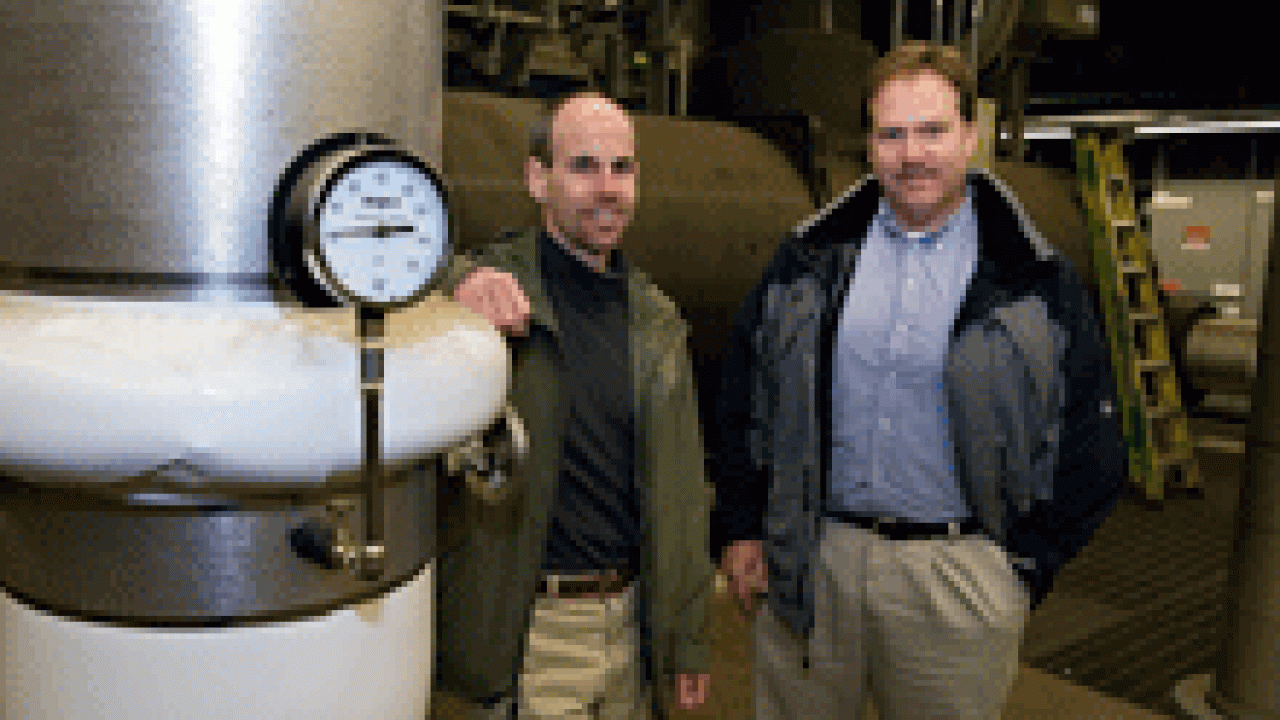Lots of campus sweat has paid off in a rebate check from Pacific Gas and Electric Co. for a cool $1.25 million.
The sweat began dripping during a heat wave two summers ago, when temperatures in late July hit 102 degrees or higher for seven consecutive days, overtaxing the campus's aged cooling system. To reduce the load, Operations & Maintenance shut down the air conditioning in several buildings, including Mrak Hall, student housing and the Activities and Recreation Center.
Soon after, a number of people in the campus's administrative and budget offices, and in other units, sweated hard to speed up part of an improvement project that was already in the planning stages. By the very next June, one new chiller was up and running, and in August a second new chiller came online — $6 million worth of work completed four years ahead of schedule.
Then, PG&E came through with the rebate, described as "icing on the cake" by David Phillips, interim director of the Utilities Division in UC Davis Operations & Maintenance. PG&E officials visited the campus last week to hand over the money, which will go toward paying the energy bill for the campus's state-supported buildings.
In recent years, state funding to pay those bills has come up short, due in part to rising energy costs and the difficulty in heating and cooling the older buildings that comprise much of the UC Davis campus. The deficit amounted to about $10 million in 2006-07, paid with general fund money that could otherwise have been used elsewhere on campus.
UC Davis committed to the chiller upgrade without knowing whether the university would qualify for a rebate. The PG&E program, mandated by the state Public Utilities Commission and funded by PG&E ratepayers, does not normally permit rebates for "fuel switching" — which is what UC Davis did: The Utilities Division took out three old chillers that ran on natural gas and replaced them with electric-powered chillers.
Nevertheless, prior to construction, the university submitted a rebate application on the premise that the project would cut the university's overall energy use, said Chris Cioni, associate director of the campus Utilities Division.
PG&E verified the energy savings, secured the PUC's approval, and cut the rebate check. It represented a one-time payment of about $1 for every therm of gas that the university will not be using in a given year: about 1.25 million.
To come up with that figure, the university calculated the difference between the amount of gas needed for the old chillers and the amount of gas that would have been needed if UC Davis had put in new gas chillers instead of electric chillers.
The university decided to swap out the gas units in part because the campus buys electricity from the federal government's Western Area Power Administration, or WAPA, at rates that beat PG&E's.
Also, by switching to electric, the campus can reduce its "carbon footprint" — because carbon dioxide emissions are greater from the burning of natural gas, compared with WAPA's hydroelectric power.
"Our new chillers are more efficient and greener," said Maurice "Mo" Hollman, associate vice chancellor for Facilities Management.
He commended his staff for being "alert" to the rebate program and persevering to get the money, despite the policy regarding "fuel switching."
Convincing the PUC to allow the rebate was an arduous process. "We had to make our case to PG&E, and then PG&E made the case to the PUC," said Cioni, explaining how PG&E brought in consultants to validate the "fuel-switching" calculations, to prove that UC Davis' chiller project was a good thing for energy conservation and the environment. Given the green light, PG&E moved quickly to make the rebate happen.
Hollman and Cioni also credited the Office of Resource Management and Planning and the Architects & Engineers unit for putting the chiller project on the fast track.
"They just cut to the chase and made the project happen quickly," Cioni said.
In light of continuing high energy bills, Hollman said the university has been "very, very aggressive" in boosting the efficiency of heating and cooling systems, mostly by going from building to building to install new and improved control systems. Also, the university plans to take out three more old gas chillers and replace them with one more electric unit.
Through a number of programs, Hollman said, the campus brought in about $1.5 million in energy efficiency rebates and grants in calendar year 2007 and is pursuing an additional $3 million worth of grants in 2008.
Hollman said he hopes to see UC Davis receive more grant money through a systemwide initiative in which UC would invest $200 million for energy conservation, with public utilities like PG&E putting in $300 million.
"This will enable us to continue our efficiency and conservation efforts," Hollman said, "and do some bigger projects."
Media Resources
Clifton B. Parker, Dateline, (530) 752-1932, cparker@ucdavis.edu
